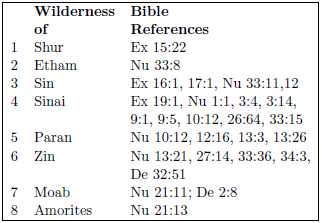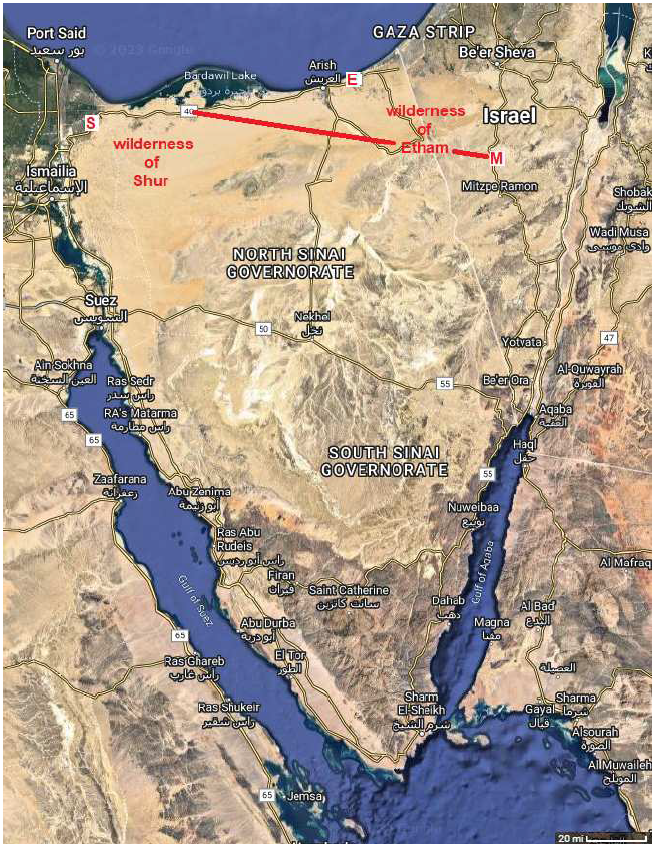
 | |
| Volume 14, Number 2 | January 30, 2024 |
Eight wildernesses are mentioned in connection with the Exodus in the historical narrative recorded in the biblical books of Exodus, Numbers, and Deuteronomy (Table 1).
A ninth wilderness, the wilderness of Kedemoth, is mentioned in Deuteronomy 2:26, but it is mentioned in connection with the start of the Eviction/Conquest rather than in connection with the Exodus, so it is not included in Table 1.
The purpose, this issue, is to assign, on a modern map, proper locations to the first two of these wildernesses of the Exodus.
Most of these eight wildernesses have been located mistakenly by modern scholarship to the present time. Exhibit A in this regard is the wilderness of Sinai, which extends outward from the base of Mount Sinai. This wilderness has traditionally been located down in the southern reaches of the (misnamed) Sinai Peninsula. The discovery that the true Mount Sinai is actually located in the Central Negev allowed this wilderness to be properly located for the first time, in the region of the modern town of Yeroham in Israel.[1]
Unfortunately, the trouble these sorts of mistakenly located wildernesses create for the student of the Bible seeking to properly understand these ancient historical records doesn't stop with just the route of the Exodus. It extends to any place in the biblical historical record of Israel where any one of these mislocated wildernesses is mentioned, both at much earlier and much later times than the Exodus. So efforts to get the locations of these wildernesses right are rewarded beyond just the present route-of-the-Exodus context.
The wilderness of Shur has historically been located east of the northern portion of Egypt. For example, from the American Tract Society Bible Dictionary:[2]
Shur: A city on the northeast border of Egypt, not far from the modern Suez,… It gave its name to the desert between it and Canaan, towards the Mediterranean,…This is close, but not quite right.
 |
Exodus 15:22 informs us that the wilderness of Shur lies adjacent to the site of the Red Sea crossing.
Then Moses led Israel from the Red Sea, and they went out into the wilderness of Shur; …If you get the site of the Red Sea crossing wrong, you will get the location of the wilderness of Shur wrong. This is what has happened historically.
Fortunately, we now know that the "Red Sea" (Hebrew: "yam suph," i.e., sea of reeds) mentioned here is the Ar Ruwaj lagoon of Lake Bardawil.[3] This locates the wilderness of Shur immediately south of Lake Bardawil, as I have previously depicted it (Figure 1).[4]
 |
This location of the wilderness of Shur is corroborated by its evident ability to solve another long-standing mystery: the location of the city of Shur. Allow me to explain.
Today, we tend to think of a wilderness as a great tract of not very populated land within defined boundaries. We think of it as a named object—the Mojave Desert, for example. Back in ancient Bible times, this appears not to have been the case. Wildernesses back then seem not to have been named at all. They were rather identified by what they were adjacent to. We see this plainly with "Etham," the name of the second Exodus encampment site, and the subsequent mention of the "wilderness of Etham." (More on this below.) We see it also, for example, with the previously mentioned "wilderness of Sinai." The proper noun—the named entity—is "Sinai," the mountain. The "wilderness of Sinai" is merely the wilderness which stretches out in front of the mountain named Sinai.
Elsewhere in the Bible, Shur appears as a dwelling place—a town or a city. For example, the biblical record of the descendants of Ishmael says:
And they settled [literally, dwelt] from Havilah to Shur which is east of Egypt as one goes toward Assyria; … (Genesis 25:18a)Thus it appears that the "wilderness of Shur" implies the existence of a city of Shur. But this city has never been located. For example, no suitable city has ever been identified where the previous quote from the American Tract Society Bible Dictionary places Shur, "not far from the modern Suez".
The reason this city has never been identified is that the generally accepted location of the Red Sea crossing—somewhere along the northeast border of Egypt—is mistaken, resulting in a mistaken assignment for the location of the wilderness of Shur.
Now that we know the correct location of the wilderness of Shur, we need only look at the map of Figure 1 to spot what must surely be the location of the ancient city of Shur. On the map is the archaeological site called "Tell el-Her." The present-day state of this ancient site can be viewed at Google Maps coordinates (30.966, 32.495). The "Tell" part signifies that this is an archaeological ruins. The "el-" part is a form of the Arabic definite article. So the meaning conveyed by "Tell el-Her" is that this is the site of the ancient city of "Her." It is but a small step to recognize the phonetic similarity between "Her" and "Shur." I propose that Tell el-Her corresponds to the biblical city of Shur as it has 1) the right location relative to the wilderness of Shur, 2) the right phonetics, and 3) the right location relative to its biblical specification "east of Egypt as one goes toward Assyria."
The wilderness of Etham is the next wilderness along the route of the Exodus to be mentioned by the biblical historical narrative. It is mentioned only briefly, and its mention easily creates some confusion. A casual reading of the ancient biblical text can easily yield either an apparent contradiction or an apparent equivalence between the wilderness of Shur and the wilderness of Etham.
The book of Exodus, in the previously quoted verse, says that the Israelites entered the wilderness of Shur after the Red Sea crossing event, but the book of Numbers places the Israelites in the wilderness of Etham, rather than the wilderness of Shur, after the Red Sea crossing event.
And they journeyed from before Hahiroth, and passed through the midst of the sea into the wilderness; and they went three days' journey in the wilderness of Etham, and camped at Marah. (Numbers 33:8)
In actual fact, neither a contradiction nor an equivalence results when one gets the geography right. Both references then make good sense in their respective contexts.
The verse above, from Numbers, places Marah in the wilderness of Etham. We know where both Marah[5] and Etham[6] are located. Google Maps coordinates for Marah are (30.822, 34.764) and for Etham they are (31.171, 33.941).
Figure 2 shows these sites on the map and the locations of the wilderness of Shur and the wilderness of Etham which they imply. The wilderness of Shur refers to the western side of the North Sinai desert, while the wilderness of Etham refers to its eastern side. When zoomed in, Google Maps shows that the Nitzana River, which emptied into the Mediterranean Sea at Etham back at the time of the Exodus (dry today), flowed through the wilderness of Etham. The headwaters of this ancient river are located only a few miles from Marah.
 |
The Israelites traveled three days, from the western side of the north Sinai desert to its eastern side, and found no water. If one is telling the history in chronological sequence as it is unfolding, as is the case in the biblical book of Exodus, then it is the wilderness of Shur which will necessarily be mentioned following the Red Sea crossing event. But if one is looking back, recounting the history for the purpose of listing encampment sites, as is the case in Numbers, then it is the wilderness of Etham which will be mentioned, because this is where Marah is located, the next encampment following the Red Sea crossing event. ◇
The Biblical Chronologist is written and edited by Gerald E. Aardsma, a Ph.D. scientist (nuclear physics) with special background in radioisotopic dating methods such as radiocarbon. The Biblical Chronologist has a fourfold purpose:
The Biblical Chronologist (ISSN 1081-762X) is published by: Aardsma Research & Publishing Copyright © 2024 by Aardsma Research & Publishing. Scripture quotations taken from the (NASB®) New American Standard Bible®, Copyright© 1960, 1971, 1977, 1995 by The Lockman Foundation. Used by permission. All rights reserved. www.Lockman.org } |
^ Gerald E. Aardsma, "Yeroham: the True Mount Sinai," The Biblical Chronologist 6.4 (July/August 2000): 1–11. www.BiblicalChronologist.org.
^ www.studylight.org/dictionaries/eng/ats/s/shur.html (accessed January 29, 2024). See also biblehub.com/ topical/s/shur.htm (accessed January 20, 2024).
^ Gerald E. Aardsma, "Understanding the Red/Reed Sea Crossing," The Biblical Chronologist 13.6 (July 11, 2023): 1–8. www.BiblicalChronologist.org.
^ Gerald E. Aardsma, "The Route of the Exodus," The Biblical Chronologist 2.1 (January/February 1996): 1–9, Figure 2. www.BiblicalChronologist.org; Gerald E. Aardsma, The Exodus Happened 2450 B.C. (Loda, IL: Aardsma Research and Publishing, 2008), 63, Figure 9.1. www.BiblicalChronologist.org.
^ Gerald E. Aardsma, "The Route of the Exodus, Part VI: The Location of Marah," The Biblical Chronologist 13.5 (June 13, 2023): 1–6. www.BiblicalChronologist.org.
^ Gerald E. Aardsma, "The Route of the Exodus, Part II: The Encampment at Etham," The Biblical Chronologist 13.1 (February 7, 2023): 1–5. www.BiblicalChronologist.org.